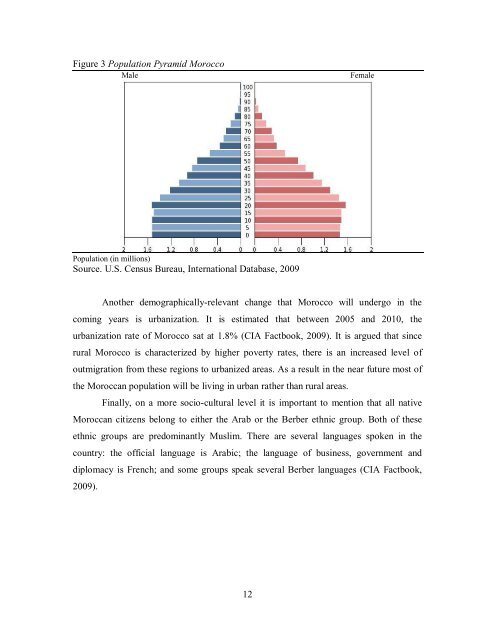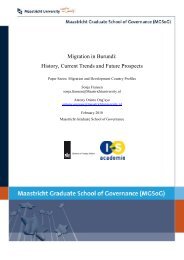Migration in Morocco: History, Current Trends and Future ... - MGSoG
Migration in Morocco: History, Current Trends and Future ... - MGSoG
Migration in Morocco: History, Current Trends and Future ... - MGSoG
You also want an ePaper? Increase the reach of your titles
YUMPU automatically turns print PDFs into web optimized ePapers that Google loves.
Figure 3 Population Pyramid <strong>Morocco</strong><br />
Male Female<br />
Population (<strong>in</strong> millions)<br />
Source. U.S. Census Bureau, International Database, 2009<br />
Another demographically-relevant change that <strong>Morocco</strong> will undergo <strong>in</strong> the<br />
com<strong>in</strong>g years is urbanization. It is estimated that between 2005 <strong>and</strong> 2010, the<br />
urbanization rate of <strong>Morocco</strong> sat at 1.8% (CIA Factbook, 2009). It is argued that s<strong>in</strong>ce<br />
rural <strong>Morocco</strong> is characterized by higher poverty rates, there is an <strong>in</strong>creased level of<br />
outmigration from these regions to urbanized areas. As a result <strong>in</strong> the near future most of<br />
the Moroccan population will be liv<strong>in</strong>g <strong>in</strong> urban rather than rural areas.<br />
F<strong>in</strong>ally, on a more socio-cultural level it is important to mention that all native<br />
Moroccan citizens belong to either the Arab or the Berber ethnic group. Both of these<br />
ethnic groups are predom<strong>in</strong>antly Muslim. There are several languages spoken <strong>in</strong> the<br />
country: the official language is Arabic; the language of bus<strong>in</strong>ess, government <strong>and</strong><br />
diplomacy is French; <strong>and</strong> some groups speak several Berber languages (CIA Factbook,<br />
2009).<br />
12



